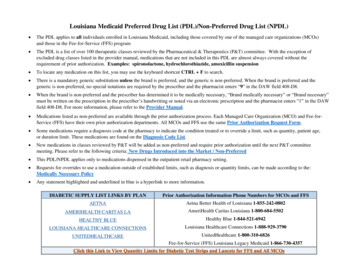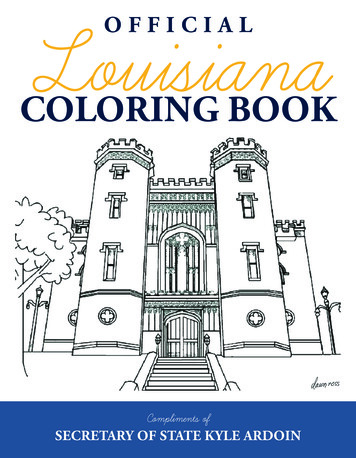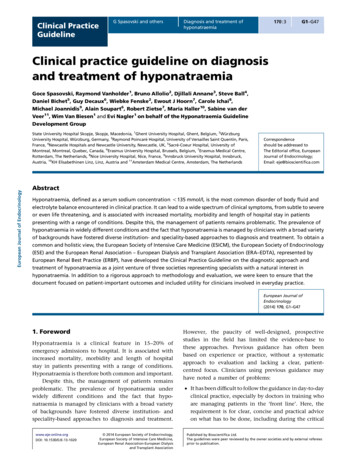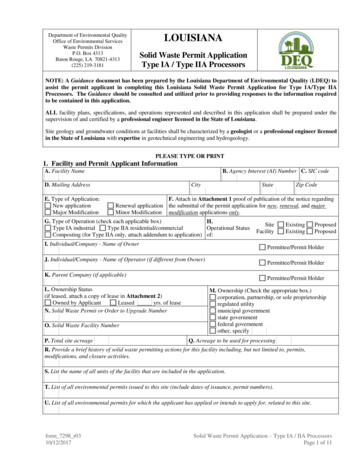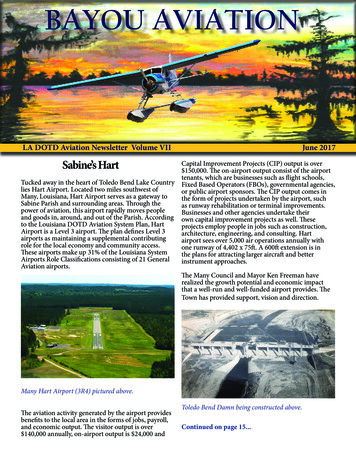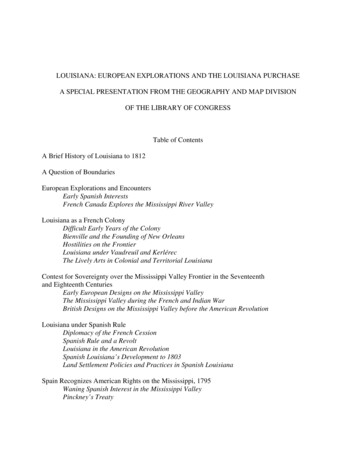
Transcription
LOUISIANA: EUROPEAN EXPLORATIONS AND THE LOUISIANA PURCHASEA SPECIAL PRESENTATION FROM THE GEOGRAPHY AND MAP DIVISIONOF THE LIBRARY OF CONGRESSTable of ContentsA Brief History of Louisiana to 1812A Question of BoundariesEuropean Explorations and EncountersEarly Spanish InterestsFrench Canada Explores the Mississippi River ValleyLouisiana as a French ColonyDifficult Early Years of the ColonyBienville and the Founding of New OrleansHostilities on the FrontierLouisiana under Vaudreuil and KerlérecThe Lively Arts in Colonial and Territorial LouisianaContest for Sovereignty over the Mississippi Valley Frontier in the Seventeenthand Eighteenth CenturiesEarly European Designs on the Mississippi ValleyThe Mississippi Valley during the French and Indian WarBritish Designs on the Mississippi Valley before the American RevolutionLouisiana under Spanish RuleDiplomacy of the French CessionSpanish Rule and a RevoltLouisiana in the American RevolutionSpanish Louisiana’s Development to 1803Land Settlement Policies and Practices in Spanish LouisianaSpain Recognizes American Rights on the Mississippi, 1795Waning Spanish Interest in the Mississippi ValleyPinckney’s Treaty
The Louisiana PurchaseNapoleonic France Acquires Louisiana"There is on the globe one single spot""The Mississippi is everything""A noble bargain"Louisiana Becomes an American TerritoryLouisiana is Transferred to the United StatesThe Cartographic Setting: Evolving European and American Conceptions ofLouisiana to 1803Earliest Renderings of LouisianaFrench Exploratory Mapping, 1670-1760–The Delisles–La Harpe to VérendryeBritish Mapping from the North, 1760-1801Spanish-Sponsored Mapping of the Missouri Basin and Lower Louisiana– Spanish Entrada into the Southwest– Second Phase– Mackay and Evans– Later MapsAmerican Exploration of LouisianaBefore 1800The First Federal Expeditions in Louisiana and the Spanish Borderlands in the Decadeafter the Purchase– Dunbar– Freeman– Pike– Lewis and ClarkBorders are Defined: Louisiana as Territory and StateLouisiana Begins to Assume Its Present ShapeProblems along the Spanish Border and the Burr ConspiracyTerritorial Growth and StatehoodThe Question of West FloridaThe Legacy of the Louisiana Purchase
A Brief History of Louisiana to 1812The Louisiana of today bears little resemblance to the vaguely defined territory acquired by theUnited States from France in 1803 for 15 million. At the time of the Louisiana Purchase no onecould present any maps or documents that delineated the boundaries of the province withreasonable accuracy. As a result of that uncertainty, the United States was more or less free toadvance its claims beyond the Mississippi River on terms favorable to its own interests.Louisiana as a province had a colorful and dramatic history in its roles as a European colony, apawn in European diplomacy, and a territory coveted by the young United States. Over thecenturies Louisiana has represented various possibilities to different interested nationalities–bothgeographically and politically. To the Spanish, Louisiana formed their northernmost borderlandin an empire stretching from Buenos Aires to California. For the French, whose ambitionsenvisioned a North American colony encompassing the entire Mississippi Valley and the GreatLakes Region into Canada, Louisiana and its immense resources held out a great deal of promise,but in reality offered very little in return. For the British, Louisiana represented a challenge toSpain’s authority in the Mississippi Valley.Louisiana’s boundaries periodically were shifted and redrawn to suit circumstances of empire.The first officially sanctioned geographic and political limits associated with the LouisianaPurchase were not laid down until the state of Louisiana was admitted to the union in 1812–thefirst state carved out of the Purchase as well as the first state west of the Mississippi.The one prominent feature of Louisiana upon which all powers agreed as being both markedlyfixed and of utmost significance for advancing national interests further west was the MississippiRiver. The largest and most important river in North America, the Mississippi held the key tocontrolling the vast interior of the continent. Indeed, the boundaries of the Louisiana Purchaserecognized today are formed by the western watershed of the Mississippi River in its entirety.Because diplomacy and accepted standards failed to define Louisiana in the early 19th century,
the Mississippi and its tributaries delimit it.Spanish explorers sailed along Louisiana’s coast as early as 1520 and encountered theMississippi River for the first time on land in 1542. The Spanish, however, never gained afoothold in the region. Nearly a century and a half later, in 1682, the famous French explorerRené Robert Cavelier, Sieur de La Salle, descended the Mississippi to its mouth and by right ofdiscovery promptly claimed the entire region for Louis XIV of France (reigned 1643-1715). Notlong thereafter, in 1699, a permanent French colony was planted on the Gulf Coast. Provingunprofitable for the French Crown, control of the colony was transferred successively to themerchant Antoine Crozat and to the Scottish financier John Law. Under the latter, the colonyexperienced some development, such as the founding of New Orleans in 1718 and theintroduction of slaves from Africa. In 1731, beset by Indian wars and continuing economiclosses, the company returned Louisiana to Louis XV (reigned 1715-74), under whom it remainedfor the next three decades.By secret treaty during the French and Indian War (1755-63) the French transferred Louisiana toSpain in 1762. The acquisition made Spain the controlling authority over the Mississippi River toits origins. Louisiana remained under Spanish rule until 1800, during which time it prospered,witnessing the germination of the vibrant cultural and artistic life for which the state is stillknown. During the American Revolution, Louisiana under Governor Bernardo de Gálvez aidedthe colonial cause against Britain by forwarding supplies to the insurgents via New Orleans andcapturing key British posts in (the province of) British West Florida. In a 1795 treaty withSpain, the United States obtained rights to navigate the Mississippi River and use the port ofNew Orleans as a place of deposit for American commodities and transshipment on oceangoingvessels.In 1800 Louisiana was ceded by Spain to France in the secret Treaty of San Ildefonso but regimechange in the colony occurred slowly. The French leader Napoleon Bonaparte viewed Louisianaand the Mississippi Valley as the cornerstone of his new colonial empire in North America.4
Spanish Intendant Juan Ventura Morales closed the port of New Orleans to American trade in thefall of 1802. The loss of those rights threatened commercial and political interests of Americansresiding west of the Appalachians. As a result, the United States, which was beginning to assertits claims to the vast unknown lands beyond the Mississippi, was forced to negotiate forcommercial privileges with a potential rival on the continent, Napoleonic France. Napoleongave up plans for reestablishing the French empire in America, however, and sold Louisiana tothe United States in 1803 for 15 million in what became known as the Louisiana Purchase.Spanish protests over the sale of Louisiana were ignored. The United States acted quickly overthe next decade to extend the region as far as possible to the west and northwest. The UnitedStates sought to include West Florida within the Purchase, delimit Louisiana’s borders to itsadvantage, define the terrain of the land, and govern Louisiana as a new territory with a view tocreating new states within the union.Realistic cartographic knowledge of the Louisiana territory in its entirety was lacking, however.Nonetheless, major segments of the area, particularly the Gulf Coast, the Mississippi River, andthe Missouri River, had been unsystematically explored and mapped by the colonial powerssince the 16th century. President Thomas Jefferson, an ardent exponent of American expansionand scientific exploration, lost no time in mounting the first federal expeditions to survey his newproperty.Nine years of territorial government under the administration of William C. C. Claibornewitnessed an uneasy transition from former colony to state. The majority of Louisiana’s FrenchCreole residents, resentful of an American intrusion into their affairs, opposed efforts by theUnited States to make Louisiana part of the federal fold. Spain meanwhile, justifiably feeling itspresence in the Gulf Coast threatened, vehemently denied that the province of West Florida waspart of the Louisiana Purchase. Within a decade, however, the region succumbed to Americaninstigated disputes and intrigue and it officially became part of the United States.5
A Question of BoundariesFrench and American representatives faced a vexing issue when they met in Paris in April 1803to negotiate a treaty by which the United States would purchase the province of Louisiana fromFrance. Since most of the territory to be exchanged had never been explored, surveyed, ormapped by any European nation or the United States, the negotiators were unable to includewithin the treaty any accurate delimitation or precise definition of the boundaries of Louisiana.Previous treaties transferring ownership of Louisiana between France and Spain never includedany boundary delineation. For those reasons, no one knew what the Purchase meant in size, nordid anyone have a realistic conception of how its overall terrain should appear on a map.All that the representatives knew was that the territory historicallyhad been bordered on the south by the Gulf of Mexico and on theeast by the Mississippi River between its mouth and its uncertainheadwaters. Undeterred by the prospects of such a limitation, orperhaps inspired by the possibilities it offered, the Americanrepresentatives agreed, according to the ambiguous language ofthe treaty of cession, to receive on behalf of the United States "theColony or Province of Louisiana with the same extent it now hasin the hands of Spain and that it had when France possessed it."The negotiators presumably would have requested the mostaccurate and comprehensive map of the continent likely to beavailable in Paris at the time. One such candidate would havebeen Aaron Arrowsmith’s 1802 Map Exhibiting All the NewDiscoveries in the Interior Parts of North America, whichembodied the most modern geographic knowledge of NorthAaron Arrowsmith, A mapexhibiting all the newdiscoveries in the interiorparts of North America :inscribed by permission to thehonourable governor andcompany of adventurers ofEngland trading into HudsonsBay in testimony of theirliberal communications totheir most obedient and veryhumble servant A.Arrowsmith, January 1st 1795.Geography and Map Division,Library of Congress. Callnumber: G3300 1802 .A7Vault CasetopAbout this imageAmerica prior to Lewis and Clark’s expedition. By today’sstandards, this map leaves much to the imagination, particularly with regard to the vast region6
known as the Far West. Louisiana is no more than a nebulous entity, its only conspicuousboundary an unspecified segment of the Mississippi River.At the time of the Purchase, both the United States and France presumed that the territory wasmade up of the Mississippi River, including the various French settlements along the full-lengthof its western bank; the Red River Valley as far as the frontier of the Spanish province of Texas;the Missouri River to undetermined limits; the town of New Orleans; and the Isle of Orleans–thatpiece of land bounded on the west by the Mississippi River, on the east by the Gulf of Mexico,and on the north, going from west to east, by Bayou Manchac, Lake Maurepas, LakePontchartrain, Lake Borgne, and the Mississippi Sound. More complicated was the small regionknown as Spanish West Florida, which was claimed by the United States as part of the treaty, aclaim later challenged by France and Spain.Even before Louisiana was acquired by the United States, President Thomas Jefferson began topress American claims farther afield. He asserted that Louisiana embraced all of the landsdrained by the western tributaries of the Mississippi, including the far-flung and unchartedheadwaters of the Missouri and the area drained by its northernmost tributaries, in addition to theWest Florida. Jefferson also planned the first transcontinental expedition prior to thenegotiations for Louisiana. Once the new territory became part of the nation, federallysponsored expeditions, guided largely by Jefferson’s counsel, set about exploring and surveyingit to define and describe Louisiana geographically; to expand the bounds of the territory as far tothe Southwest, the West, and the North as far as possible; and to make the region’s lands andpeoples subject to the authority of the United States. Those efforts produced the first reasonablyaccurate delineations of the American West and began to give formal shape to the boundaries ofthe new territory.The first printed map depicting the topography of the Louisiana Purchase was published in 1804in an atlas by Aaron Arrowsmith. All of the American maps within the atlas, including the oneidentified simply as Louisiana, were drawn by the American cartographer and draftsman,7
Samuel Lewis. Arrowsmith and Lewis based their product upon thebest information at hand. Their representation of the upperMississippi and Missouri basins, for example, was borrowed from agroundbreaking map of the American West drawn in St. Louis in 1795by French engineer Pierre Antoine Soulard. Louisiana, however,included several readily evident errors and blank spaces, among thembeing a South Fork of the Platte River which extends far south intopresent-day New Mexico; the omission of the great Colorado River ofthe West, still awaiting discovery by the United States; an uncertainsource of the Mississippi; the Rocky Mountains portrayed too far tothe west and in a single broken chain; and a minimized ColumbiaRiver system.Aaron Arrowsmith andSamuel Lewis, Louisiana,1804. From their Newand Elegant GeneralAtlas, Philadelphia,1804,plate 55. Geography andMap Division, Library ofCongress. Call number:G4050 1805 .L4 TILAbout this imageOnce federal explorations of the West were underway, it was only amatter of time before their newly uncovered wealth of information found cartographicexpression. One of the earliest commercially issued maps toincorporate data from the famed 1804 transcontinental expedition ofMeriwether Lewis and William Clark appeared in an atlas issued byPhiladelphia publisher Matthew Carey in 1814. The map, alsodrawn by Samuel Lewis, depicts the Missouri Territory FormerlyLouisiana, which was organized in 1812, the year that the first stateLouisiana was created out of the Louisiana Purchase area (theMissouri Territory comprised the remaining lands). The "probablenorth boundary of the Missouri Territory," is at odds with Britishclaims to the Pacific Northwest–in fact, the "probable" northern andsouthern boundaries appearing on Missouri Territory FormerlyMatthew Carey, MissouriTerritory formerlyLouisiana, 1814.Geography and MapDivision, Library ofCongress. Call number:G4050 1814 .C3 TILAbout this imageLouisiana correctly intimate that the United States had assumed years of border disputes withSpain and Great Britain.8
Within two decades of the Purchase, official boundaries had been realized either through treatyor annexation. The first major adjustment occurred in 1810, when a revolt in that part ofLouisiana known as Spanish West Florida–today the Louisiana parishes east of the MississippiRiver and of Lake Pontchartrain, led the United States to annex the territory from the Mississippito the Pearl River.After 1815 the United States concluded treaties with both Great Britain and Spain. As a result ofthe treaty with Britain, the 49th parallel from the Lake of the Woods (along the present border ofMinnesota and Canada) to the continental divide of the Rocky Mountains was established as thenorthern boundary of the Louisiana Purchase, and the United States gained territorial rights tothe Pacific Coast. Under the terms of the 1821 Adams-Onis Treaty, also known as theTranscontinental Treaty, Spain ceded East Florida–an area of Floridaextending east of the Appalachicola River to the Atlantic Ocean–tothe United States. The treaty set the western boundary of Louisianaalong the Sabine and Red rivers which separate Texas andLouisiana, then north along the 100th meridian to the ArkansasRiver–which it followed westward to its source in the Rockies, thennorth to the 42nd north latitude, and on a line then west to the PacificOcean. An undated subsequent edition of Missouri TerritoryFormerly Louisiana by Carey and Lewis, probably published after1818, has been amended by hand in watercolor to record some of thetreaty adjustments.Matthew Carey, MissouriTerritory formerlyLouisiana, 1814.Geography and MapDivision, Library ofCongress. Call number:G4050 1814 .C31 TILAbout this imageBy 1823, when the last bonds issued in Great Britain and the Netherlands for financing thepurchase were paid off with interest by the United States Treasury, the total spent for Louisianaamounted to 23,313,567.73. As if sympathetic to President Jefferson’s assertions, theboundaries of Louisiana expanded and adjusted over time until they eventually stretched fromthe Gulf of Mexico to British America (present-day Canada) and from the Mississippi River tothe Rocky Mountains. Today the lands constituting the Louisiana Purchase are estimated to9
cover between 850,000 to 885,000 square miles. Areas once part ofLouisiana form six states in their entirety: Arkansas, Iowa, Missouri,Nebraska, Kansas, and Oklahoma; most of the states of Louisiana,Minnesota, North Dakota, South Dakota, Montana, Wyoming, andColorado; and sections of New Mexico and Texas. At the time ofthe Purchase, small segments of the Canadian provinces of Albertaand Saskatchewan also were presumed part of the transaction.Boundaries of the LouisianaPurchase as recognizedtoday.European Explorations and EncountersEarly Spanish InterestsLouisiana’s coast and the mouth of the Mississippi River were observed by the Spanish as earlyas 1519. Just over 20 years later the Spanish explorer Francisco Vásquez de Coronado and hisparty became the first Europeans to venture into the part of theregion that was acquired in the Louisiana Purchase. Coronado andhis men journeyed north out of Mexico as far as present-dayNebraska, which they probably reached in 1541. Two years earlieranother team of Spanish explorers, headed by Hernando de Soto,began to penetrate the southeastern interior of what is now theUnited States, and in 1541 became the first Europeans to officiallysight the Mississippi River inland. Following Soto’s death in June1542 and his subsequent burial in the Mississippi, his followerswandered through Texas and Louisiana, finally returning to the riverand descending to the Gulf of Mexico by way of the river’s mouth.Antonio Arredondo,Descripcion Geografica, dela parte que los Espanolesposeen Actualmente en elContinente de la Florida . . ., 1742 / 1914. Geographyand Map Division, Libraryof Congress. Call number:G3860 1742 .A7 1914 TILVaultAbout this imageSoto’s expedition laid the groundwork for later Spanish claims to the entire Southeast.10
In search of rumored material wealth but encountering mainlyprivations, the surviving members of the Soto expedition whoreturned to Spain carried with them valuable firsthand information.This information was included in Gacilaso de la Vega’s La Floridadel Inca, a 1605 publication recounting the Soto expedition throughFlorida and southeastern North America. The observations of theregion’s terrain and inhabitants also appeared on what is the onlysurviving contemporary, and possibly the first, cartographicrepresentation of the lower Mississippi Valley and the interior of thepresent-day United States as seen by a party of European explorers.Many details from that manuscript map, compiled around 1544 inAlonso de Santa Cruz,[Map del Golfo y costa de laNueva EspaZa],1572.Geography and MapDivision, Library ofCongress. Call Number:G3860 1572 .S3 Vault : Low60 [photostat of an originalin the Archivo General deIndias, Sevilla, Spain]About this imageSeville by Spanish royal cartographer Alonso de Santa Cruz,appeared on La Florida.This map was included by the Flemish cartographer and publisher,Abraham Ortelius, in the 1584 edition of his monumental atlas,Theatrum Orbis Terrarum.Besides illustrating the same region and relying on similar outlinesof the coasts, both the manuscript map and its printed offspringcontain many equivalent names. There are 22 Native-Americanvillages on La Florida; some reportedly visited by the Soto party.All the villages are represented pictorially and identified by name, afew of them still recognizable, such as "Tascalisa" (Tuscaloosa) and"Chiacha" (Choctaw). The appearance of the Mississippi River onAbraham Ortelius, LaFlorida. Auctore Hieron.Chiaves, 1584. [FromOrtelius’ Theatrum OrbisTerrarum, Antwerp, 1584.]Geography and MapDivision, Library ofCongress. Call number:G3290 1584 .O7 VaultAbout this imageLa Florida (“Rio del Spirito Santo,” or River of the Holy Spirit) isthe earliest reference to the Mississippi River on a printed map. The unnatural manner in whichthe other rivers branch and link reflect a European misinterpretation of geographic information,particularly distances and travel networks, as understood and provided by Native Americaninformants.11
French Canada Explores the Mississippi River ValleyAlthough French coureurs de bois (illegal traders) are believed to have reached the northernMississippi River by 1659, official exploration of the Mississippi commenced in 1665 with theappointment of Jean-Baptiste Talon as intendant (chief civil administrator) of New France.Talon resolved to expand French governmental control over the Great Lakes Region. Heengaged an expedition to locate and survey the fabled Great River, or Father of Waters, rumoredto flow through the American interior either into the Gulf of California or the Pacific Ocean tothe west, or into the Gulf of Mexico in the south. Firsthand knowledge of the river and charts ofits course gave New France a definite advantage in its contest with Great Britain and Spain forrule over North America. A chain of forts and trading posts extending from the lower reaches ofthe river to the St. Lawrence stemmed the advance of the English, already established atHudson’s Bay and along the Atlantic seaboard.Once France had officially declared sovereignty over virtually all ofNorth America in 1671, Talon was ready to dispatch his expeditionfor exploring and mapping the Mississippi Valley. As its leader hechose the French Canadian surveyor, cartographer, and explorerLouis Jolliet, who was accompanied by Jacques Marquette, a Jesuitmissionary and scholar of Indian languages. They embarked in May1673, and following the course of the Wisconsin River, reached theGreat River on June 17, exactly one month later.Talon’s successor, Louis de Buade, le comte de Frontenac et dePalluau, became the expedition’s patron. Jolliet called the GreatRiver "Riviere Buade" in honor of the governor’s family name. ThisLouis Joliet, NouvelleDecouverte de PlusieursNations Dans la NouvelleFrance en L’annee 1673 et1674, 1674. [Facsimile fromThe Jesuit Relations, vol.59, opp. p. 86.] Geographyand Map Division, Libraryof Congress. Call number:G3300 1674 .J6 1896 TILAbout this imagemap is based upon the one that Jolliet prepared from memory following the journey. Althoughthe expedition never descended beyond the mouth of the Arkansas River, the map displays an12
assumed rendering of the "Riviere Buade" all the way to the Gulf of Mexico.In addition to having deduced the Mississippi’s course to the south,Marquette and Jolliet first reported on the Missouri River, whichthey called by its Native American name, Pekitanoui, or MuddyRiver. Marquette, in his memoir, erroneously proposed the Missourias a route to the Pacific Ocean. The first published depiction of thediscoveries of Marquette and Jolliet appeared in a map drawn by theFrench traveler and writer, Mélchisédech Thévenot, to accompany aprinted version of Marquette’s narrative included in Thévenot’sRecueil de Voyages in 1681.One year after Thévenot’s map provided the Western world with itsMélchisédech Thévenot,Carte de la decouverte faitel’an 1673 dans l’AmeriqueSeptentrionale, 1681. Fromhis Recueil de Voyages deMr. Mélchisdec Thévenot . ., Paris, 1681. Rare Bookand Special CollectionsDivision, Library ofCongress. Call number:G159 .T38 05022117General collAbout this imageinitial view of the Mississippi River, La Salle took formal possessionof the Mississippi Valley for France and moved towards his goal ofbuilding a French commercial and military empire stretching from theSt. Lawrence Seaway to the Gulf of Mexico. At a time when Frenchenergies and finances were devoted to wars in Europe rather thancolonies in America, La Salle’s confidence gained the support ofGovernor Frontenac and the endorsement of the French Crown forerecting forts in western New France and profiting from a monopoly inhides.Despite setbacks that would have discouraged a less audacious man, LaSalle pursued his quixotic agenda by bold means. An enemy ofCanadian fur traders and Jesuits, he was befriended by the indomitablesoldier and explorer Henri de Tonti. With Tonti, the priests ZenobiusRobert Cavalier de laSalle, profile, facing left,n.d. Engraved for theMagazine of AmericanHistory from aphotograph of theoriginal painting. Printsand PhotographsDivision, Library ofCongress. Reproductionnumber: LC-USZ625545]About this imageMembré and Louis Hennepin, and a group of French and Canadian woodsmen, laborers, andNative Americans, La Salle entered the Mississippi in early February 1682 and reached its mouth13
three months later.In order to sustain what tenuous hold La Salle and France had on the lower Mississippi Valley, afort and colony needed to be established at the river’s mouth to guard against English or Spanishintrusions. La Salle repaired to France to seek the crown’s support. Realizing that royalpatronage would be withheld if his colony could not be proven economically viable, he wasforced to compromise the integrity of his project, falsifying the geography of the river’s course.La Salle described its mouth as being far west of its true location by about 8 degrees oflongitude, or roughly 500 miles, where it would serve as an ideal location for staging incursionsinto Spanish settlements and attacks on the silver mines of northern Mexico.J. B. L. Franquelin, Cartede la Louisiane ou desvoyages du S[ieu]r de laSalle . . . 1684. [Facsimilefrom The Jesuit Relations,vol. 63.] Geography andMap Division, Library ofCongress. Call number:G3300 1684 .F7 1896 TILAbout this imageJ. B. L. Franquelin,Amerique Septentrion[a]lle,1686. [Manuscript copy ofan original in theBibliothPque du Depôt desCartes et Plans de laMarine, Paris.] Geographyand Map Division, Libraryof Congress. Call number:G3300 1686 .F7 VaultAbout this imageJ. B. L. Franquelin, Carte del’Amérique septentrionale, 1688.[Manuscript copy of an original in theBibliothPque du Depôt des Cartes etPlans de la Marine, Paris.] Geographyand Map Division, Library of Congress.Call number: G3300 1688 .F Vault :OversizedAbout this imageLa Salle’s fraudulence manifested itself in a famous 1684 manuscript map. Subsequent maps byJean Baptiste Louis Franquelin, such as his 1686 map, continued to depict the Mississippi’sterminus inaccurately, while a more elaborate 1688 map incorporated new information, yet wasbased heavily upon its predecessors.14
Having gained French support for his project, La Salle attempted to return to the Mississippi byway of the Gulf Coast in 1684-85, but his ships missed the mouth of the river and the expeditionlanded at Matagorda Bay, Texas. Two years of starvation and disease followed and subsequentlya mutiny took his life. La Salle failed to establish a permanent colony in the lower MississippiValley but he did plant French claims over the vast region that eventually became the LouisianaPurchase.Louisiana as a French ColonyDifficult Early Years of the ColonyFrom its inception Louisiana faced an inauspicious existence. Its fatewas bound to the French economy during the last years of the reign ofLouis XIV. Already a vast empire, the French government and itshighly centralized bureaucracy disfavored policies that would havenurtured the economic independence of its colonies. Further, theFrench treasury, depleted by wars in Europe, was unable to financeadequately the Department of the Marine, which oversaw colonialoperations.Although all French colonies were subject to the same desperatecircumstances, the Mississippi colony, as the newest in the Frenchimperial system, fared the worst. This 1701 map by Nicholas de Ferdepicts the colony in its infant stages, a period when Louisiana’ssettlers were neglected by the government and left entirely to their ownresources. Lured by promises of mines and gold, most of the earlysettlers made little effort to hunt or plant crops. Few farms developedalong the banks of the Mississippi or along the sandy coast. Since the15Nicholas de Fer, Lescostes aux environs de laRiviere de Misisipi.Découvertes par Mr. dela Salle en 1683. Etreconues par Mr. leChevallier d’Iberville en1698. et 1699, 1701.From his L’Atlas curieux. . ., Paris, 1700-05.Geography and MapDivision, Library ofCongress. Call number:G4042.M5 1701 .F4Vault : Low 251About this image
earliest settlers were never furnished with adequate food supplies, they frequently resorted toscavenging for crabs, crayfish, and seeds of wild grasses. Whenever possible they tradedblankets and utensils for corn and game with t
Geography and Map Division Subject: A special presentation about the Louisiana Purchase Keywords: louisiana, louisiana purchase, united states, france, spain, territories, exploration, explorers Created Date: 7/20/2007 2:49:06 PM

